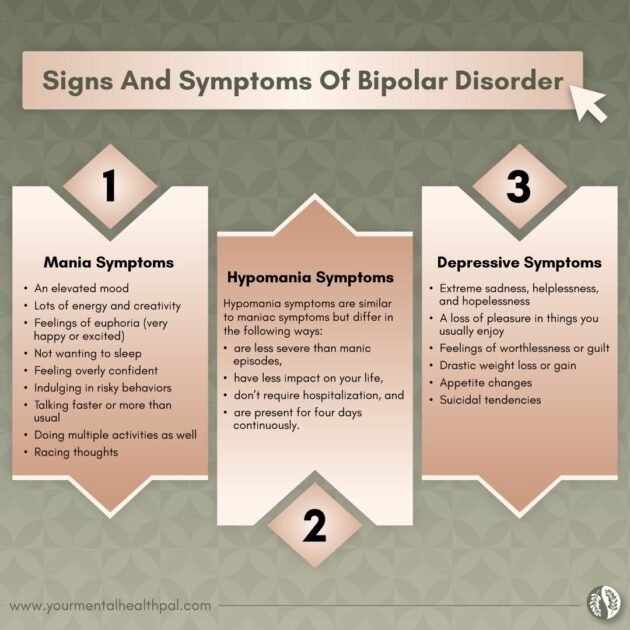Mood swings are a regular part of our lives. But when do these mood swings become signs of bipolar disorder (BP)? After all, we all experience emotional highs and lows every few days, and that’s not really a sign of something bad going on.
For some people, though, the mood swings are so severe and extreme that they don’t even realize what they are feeling after that. And, for these people whose emotional mood swings are more debilitating, draining, and persistent, they can be signs of mental health conditions like bipolar disorders.
Bipolar disorder is a condition marked by extreme mood swings that cause a drastic difference in a person’s energy and activity levels. For people with bipolar disorder, feeling up means making dangerous decisions or having hallucinations. And feeling down means not having the energy to get out of bed.
As per the National Institute of Mental Health (NIMH), bipolar disorder affects around 4.4% of the total American population. So, there’s a real chance you might know or will know someone dealing with the condition. However, that doesn’t really stop the misinformation and stigma associated with the condition.
People with bipolar disorder are often considered unreliable and dangerously violent. Bipolar disorder’s symptoms are reduced to behavioral choices that patients deliberately make. While all this isn’t true, breaking these myths and sifting through the misinformation is important for allowing individuals with the condition to get the required help and support.
This is why learning about bipolar disorder is essential.
In this blog post, we will break down bipolar disorder, its symptoms, causes, and available treatment options.
But before we get started, here’s something important.
Mental and neurological health are diverse and complex. They exist on a spectrum, and every individual has their own experiences. Therefore, don’t start diagnosing yourself with the knowledge you get by reading a few articles on the Internet (though we are incredibly grateful to you for stopping by to enhance your understanding of an important topic). If you find this article helpful or resonate with the symptoms explained in it, consider this as the beginning of your journey of getting the right help.
That’s it. Let’s dive in!
What Is Bipolar Disorder?

As the name suggests, bipolar disorder is defined by polar opposite mood swings – at one point, you have the energy to conquer the whole world, and the next, you can barely get yourself out of bed. These shifts in energy, thinking, and activity can last for a few hours, days, or even weeks, significantly affecting a person’s ability to carry out their regular activities.
Initially known as manic depression, bipolar disorder affects around 2.8% of adults in America. However, approximately 4.4% of people will have the condition at some point. Over 82% of these affected individuals say that bipolar disorder significantly affects their lives – which is the highest for any type of mood disorder.
The prevalence of the disorder is nearly equal in both males and females. The average age for the diagnosis of bipolar disorder is 15-25 years. As per research published in the International Journal of Bipolar Disorders, the life expectancy of patients decreases by almost 15 years due to substance abuse.
Most people denote bipolar disorder as a fluctuation between extreme mood swings – mania and depression. However, the difference can be extremely subtle in some people.

What Are The Different Types Of Bipolar Disorder?
Bipolar disorder generally causes emotional ups and downs in a person, but it can manifest differently in people. Here are the main types of bipolar disorder:
1. Bipolar I
Bipolar I is the most severe type of bipolar disorder because it causes more severe symptoms that last longer. Bipolar I is diagnosed in people who have at least one maniac episode lasting for a week or resulting in psychiatric hospitalization. It must be followed or preceded by a depressive or hypomanic (less severe form of manic episode) episode.
Manic episodes are defined by euphoric feelings that leave you feeling elated. You might have little interest in sleeping or eating during these episodes. You have more energy than you can process. Therefore, you eat, act, and even think faster. Patients can develop absurd notions during this period, like they are on a mission to save the world.
Bipolar I has a high recurring rate, and 50% of those with the condition have a second episode within two years of having the initial episode.
2. Bipolar II
Bipolar II does not have very intense maniac episodes like Bipolar I. Instead, it is characterized by depression and hypomanic episodes. Hypomanic episodes are less severe forms of mania and usually last for four days.
The affected individual might feel more energetic and upbeat during a hypomanic episode. However, they may be more reckless in activities like spending or sexual indulgence. While there’s still a change in the energy, it’s less noticeable and dangerous than manic episodes.
To be diagnosed with Bipolar II, people need to have one hypomanic episode lasting for four days and one depressive episode. While the hypomanic episodes are not as long, people with Bipolar II can stay depressed for longer periods, which can affect their ability to function adequately.
3. Cyclothymic Disorder
In cyclothymic disorder, individuals have both hypomanic and depressive symptoms for over two years, but the severity isn’t enough for them to be diagnosed as Bipolar II. Simply put, the moods and behaviors of people with cyclothymic disorder are oscillating between periods of elevated moods and mild depression. However, the condition is not severe and is extremely responsive to treatments.
4. Unclassified bipolar disorder
In some instances, people showcase symptoms of bipolar disorder but do not accurately fit the criteria of classification. For instance, substance abuse can complicate the diagnosis of bipolar disorder because it gets difficult to identify whether the mood swings occur due to drug or alcohol use, genetics, or both.
What Are The Signs Of Bipolar Disorder?

Bipolar disorder’s symptoms are classified into three major categories:
- manic symptoms,
- hypomanic symptoms, and
- depressive symptoms.
1. Mania Symptoms
- An elevated mood
- Lots of energy and creativity
- Feelings of euphoria (very happy or excited)
- Not wanting to sleep
- Feeling overly confident
- Indulging in risky behaviors
- Talking faster or more than usual
- Doing multiple activities as well
- Racing thoughts
2. Hypomania Symptoms
Hypomania symptoms are similar to maniac symptoms but differ in the following ways:
- are less severe than manic episodes,
- have less impact on your life,
- don’t require hospitalization, and
- are present for four days continuously.
3. Depressive Symptoms
- Extreme sadness, helplessness, and hopelessness
- A loss of pleasure in things you usually enjoy
- Feelings of worthlessness or guilt
- Drastic weight loss or gain
- Appetite changes
- Suicidal tendencies
What Are The Causes Of Bipolar Disorder?
Just like other mental health conditions, the scientific jury is still out there on the exact causes of bipolar disorder. However, a combination of the following risk factors is deemed responsible:
1. Family History
While genes alone aren’t responsible for the development of bipolar disorders, as per the NIMH, it does actually run in families. Statistics from the American Psychiatric Association (APA) say that around 80-90% of people diagnosed with the condition have a family history.
However, there is no knowledge about the specificity of the genes that can be potential causes of bipolar disorder.
2. Childhood Trauma
As per research published in the International Journal of Bipolar Disorders, having traumatic experiences during childhood can also lead to the development of bipolar disorder. These traumatic experiences include everything from physical to sexual abuse, neglect, or unstable support systems while growing up.
3. Neurological Differences
According to NIMH, there are significant neurological differences in how the brain functions in people with bipolar disorder. Research has shown specific dysfunctions in areas focused on emotional regulation (amygdala and anterior cingulate) in people with the condition. However, it’s unclear whether this is one of the causes of bipolar disorder or a consequence of it.
How Is Bipolar Disorder Diagnosed?
Bipolar disorder diagnosis is a fairly complex process, but early detection and treatment are keys to proper recovery. If you or your loved one has signs of bipolar disorder, it’s imperative to start the diagnostic process as soon as possible.
Initially, checking with yourself and understanding what you are feeling is essential. Try to figure out how long your feelings have persisted. If your answer is two weeks or more, contact your healthcare provider. While only a mental health professional can give a bipolar diagnosis, your healthcare provider can give you the right referral.
A doctor will diagnose your condition using the Diagnostic and Statistical Manual (DSM-V) criteria. To have a proper diagnosis, the doctor might follow these steps:
- Mental health evaluation
- Mood journaling
- Physical examinations
What Does The Treatment For Bipolar Disorder Look Like?
While there is no surety about the causes of bipolar disorder, doctors have identified various treatment options that are extremely beneficial in dealing with the condition. For most people, the treatment is a combination of psychotherapy and medications.
Finding the right bipolar disorder treatment is a trial and error-process. Certain specific types of medications might be more or less suited for you. This whole process might take a month or two before you can fully dedicate to a designated treatment plan.
One of the most challenging parts about having bipolar disorder is to stick to your treatment line in the long term. Most patients stick to medications for a larger part of their life, but it might get difficult when you don’t see apparent symptoms.
The common medications used to treat bipolar disorder are:
- mood stabilizers,
- anticonvulsants,
- atypical antipsychotics, or
- antidepressants.
Disclaimer: The above-suggested medications should only be used after proper diagnosis and discussion with professionals. Unregulated use can be life-threatening.
Conclusion:
Bipolar disorder is a severe mental health mood disorder. While there’s a lot of stigma regarding the condition, it’s essential to understand that it’s highly treatable, and individuals with the condition can live a healthy life.
Finding timely help is one of the most important parts of dealing with the condition. If you feel you have any signs of bipolar disorder, consult with a mental health specialist right away.
Apart from this, keeping track of your moods and feelings is one of the best ways to help yourself. Here are the best mood-tracking apps to help you monitor your daily moods. To continue learning about mental health daily, subscribe to Your Mental Health Pal.

